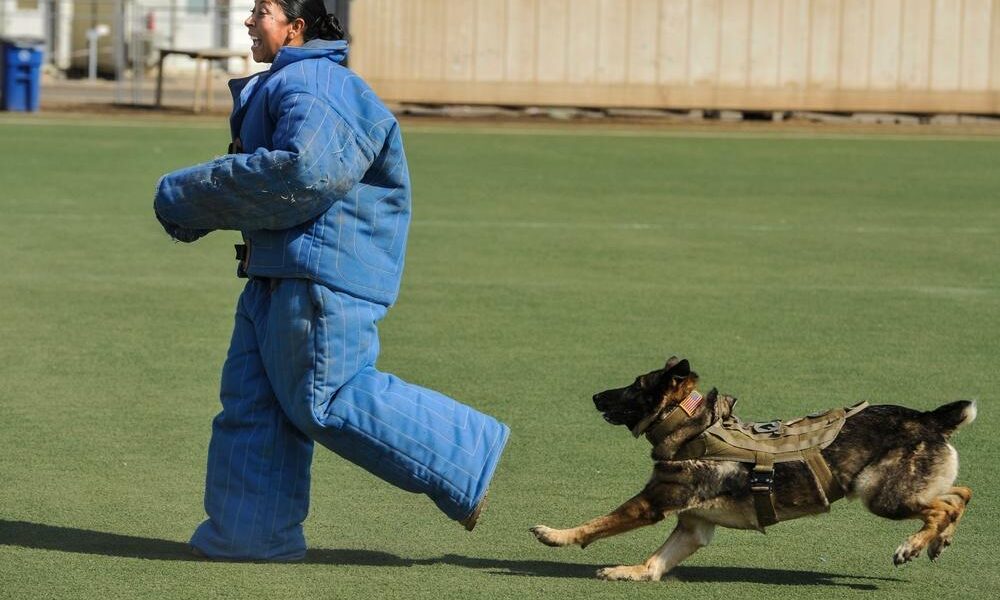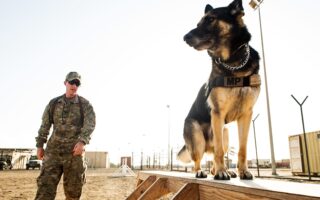Unleashing Potential: The Art and Science of K9 Training
In a world where the bond between humans and dogs transcends mere companionship, K9 training emerges as a dynamic field that bridges communication and understanding between species. This specialized training not only sharpens a dog’s instincts and abilities but also fosters a deeper connection, enhancing both their lives and those of their handlers. From elite service dogs tasked with aiding law enforcement to beloved pets mastering basic obedience, K9 training encompasses a spectrum of practices rooted in behavioral science and empathy. As we explore the principles, methodologies, and transformative effects of K9 training, we uncover a fascinating narrative of collaboration, growth, and the remarkable potential lying within every canine companion. Join us on this journey as we delve into the intricacies of training techniques, the importance of positive reinforcement, and the enduring impact of a well-trained dog on our lives and communities.
Table of Contents
- The Foundations of Effective K9 Training Techniques
- Understanding Canine Behavior to Enhance Training Success
- Creating a Positive Learning Environment for Your Dog
- Essential Tools and Resources for Aspiring K9 Trainers
- Q&A
- To Conclude
The Foundations of Effective K9 Training Techniques
Understanding the principles behind K9 training is essential for both trainers and dog owners. At the core, effective techniques are built on the foundation of positive reinforcement, where desirable behaviors are encouraged through praise, treats, or play. This approach not only fosters a trusting relationship between the trainer and the dog but also enhances the learning experience. Key elements that contribute to a successful training process include:
- Consistency: Applying the same commands and rewards helps the dog understand expectations.
- Timing: Providing immediate feedback reinforces the behavior in question.
- Patience: Every dog learns at their own pace, and understanding this will lead to better outcomes.
Another critical component of effective training is understanding canine behavior. Each dog is unique, which means that techniques should be tailored to individual personalities and learning styles. Recognizing body language can provide insight into a dog’s mood and responsiveness. A table highlighting some common behaviors and appropriate training responses can be incredibly beneficial:
| Behavior | Response |
|---|---|
| Excited jumping | Redirect with a sit command and reward calmness. |
| Unwanted barking | Teach the “quiet” command and reward silence. |
| Fearful behavior | Offer reassurance and gradual exposure to the fear source. |
Understanding Canine Behavior to Enhance Training Success
To achieve effective training outcomes, it’s crucial to tap into the intricate nuances of canine behavior. Each dog possesses a unique personality shaped by genetics, upbringing, and past experiences. Understanding these factors can significantly enhance your training techniques, fostering a more productive environment. By recognizing how a dog communicates, reacts to various stimuli, and engages with its surroundings, trainers can tailor their approaches to meet individual needs. Here are some important considerations:
- Body Language: Dogs convey emotions and intentions through their posture, tail position, and facial expressions.
- Socialization: Early exposure to different environments, people, and other animals is critical for a well-behaved dog.
- Reinforcement Techniques: Positive reinforcement aligns with a dog’s natural instincts, making them more motivated to learn.
Additionally, creating an enriching environment that stimulates a dog’s natural abilities can significantly boost training success. Providing opportunities for mental and physical exercise helps dogs develop trust in their handlers and enhances their learning capacity. Incorporating games like fetch or interactive toys during training sessions can transform the experience into a fun bonding activity. Consider using a simple table to outline various training tools and their purposes:
| Tool | Purpose |
|---|---|
| Clicker | Marks desired behavior instantly for clarity. |
| Treats | Rewards for positive behavior, encouraging repetition. |
| Leash | Provides control and ensures safety during training sessions. |
Creating a Positive Learning Environment for Your Dog
Creating a nurturing atmosphere is essential for effective k9 training. A positive learning environment can significantly impact your dog’s ability to grasp new commands and behaviors. It’s important to recognize that dogs, much like humans, respond better to encouragement and support. Here are some tips to foster a constructive space for your pup:
- Consistency is Key: Use the same cues and commands so your dog learns effectively.
- Positive Reinforcement: Reward desirable behavior with treats, praise, or toys to keep your dog’s motivation high.
- Short Training Sessions: Keep sessions brief and focused to prevent frustration and maintain interest.
- Calm and Patient Approach: Model behaviors and communicate in a relaxed manner to help your dog feel at ease.
Another crucial element is the use of engaging and diverse training techniques. Mixing up the drills can make learning more exciting for your dog. Consider incorporating activities that stimulate both mental and physical well-being. Here’s a quick overview of effective training methods:
| Training Method | Description |
|---|---|
| Clicker Training | Utilizes a clicker sound to mark correct behaviors, followed by a reward. |
| Freestyle Obedience | Combines tricks and commands in a fun routine, promoting enjoyment. |
| Agility Training | Involves obstacle courses that enhance coordination and confidence. |
Essential Tools and Resources for Aspiring K9 Trainers
For aspiring K9 trainers, having the right tools and resources is crucial for effective training and communication with dogs. Various training aids can enhance learning experiences and ensure positive outcomes. Some must-have items include:
- Clickers: Ideal for positive reinforcement and shaping behaviors.
- Leashes: A sturdy and versatile leash is essential for safe and controlled training sessions.
- Treat bags: Convenient for carrying rewards and keeping hands free.
- Fetch toys: These can be used not only for play but also to teach commands like “retrieve.”
In addition to physical tools, educational resources play a vital role in a trainer’s development. Leveraging knowledge from various sources can refine techniques and expand understanding of canine behavior. Consider the following resources:
- Books: Titles like “The Other End of the Leash” and “Don’t Shoot The Dog!” offer valuable insights.
- Online courses: Websites like Coursera and Udemy provide in-depth training programs.
- Forums and communities: Engaging in platforms like Reddit or Facebook groups can provide real-time advice and support.
- Mentorships: Connecting with experienced trainers can offer hands-on guidance and practical experience.
Q&A
Q&A: Unlocking the Secrets of K9 Training
Q1: What is K9 training, and why is it essential?
A1: K9 training refers to the process of teaching dogs various skills, behaviors, and tasks to enable them to assist humans in numerous roles, from companionship to law enforcement and search-and-rescue operations. This training is essential as it ensures that dogs can effectively perform their duties while also fostering a strong bond between the handler and the dog.
Q2: What types of K9 training are most common?
A2: K9 training comes in various forms, including obedience training, agility training, detection work (like drugs or explosives), and protection training. Each type serves specific purposes, ranging from basic commands like “sit” and “stay” to more complex tasks that aid in public safety or competitive sports.
Q3: How does K9 training differ for specialized roles, like police or therapy dogs?
A3: Specialized K9 training is tailored to meet the specific needs of the role. For police dogs, training focuses on skills such as tracking, detecting substances, and apprehending suspects. In contrast, therapy dogs undergo socialization and gentle obedience training to ensure they can interact calmly with people in various settings, providing support and comfort.
Q4: What are the fundamental principles of effective K9 training?
A4: Effective K9 training is built on consistency, positive reinforcement, and patience. Training should be fun and engaging for the dog, using rewards like treats, toys, or praise to encourage desired behaviors. Moreover, handlers need to maintain a calm demeanor, reinforcing the idea that training is a collaborative and positive experience.
Q5: Can any dog become a K9, or are there specific breeds better suited for this role?
A5: While any dog can undergo basic training, certain breeds are often better suited for specialized K9 roles due to their temperament, intelligence, and physical capabilities. Breeds like German Shepherds, Belgian Malinois, and Labrador Retrievers are popular choices for police and service work, whereas smaller or less active breeds can excel in therapy roles.
Q6: How long does it typically take to train a K9, and what is the training process like?
A6: The training duration can vary significantly based on the dog’s age, breed, and intended role. Basic obedience training can take a few weeks to several months, while specialized training may take six months to a year or longer. Training generally involves a mix of private sessions, public exposure, and real-world simulations to ensure dogs are well-prepared for their eventual duties.
Q7: What challenges might arise during K9 training, and how can they be overcome?
A7: Common challenges include distractions, fear responses, and inconsistent behavior. Overcoming these issues requires patience, adaptability, and often a tailored training approach. Gradually exposing the dog to challenging environments, using high-value rewards to engage them, and seeking professional guidance when necessary can help address these challenges effectively.
Q8: How can pet owners incorporate K9 training principles into their daily lives?
A8: Pet owners can easily incorporate K9 training principles by engaging in fun, short training sessions at home, practicing commands regularly, and rewarding their dogs for good behavior. Simple activities like teaching new tricks, going for structured walks, and using positive reinforcement can enhance the relationship between the owner and their pet while laying the groundwork for good behavior.
Q9: What resources are available for those interested in pursuing K9 training?
A9: Those interested in K9 training can find numerous resources, including books, online courses, and local training clubs. Many communities also have professional trainers and specialized K9 schools that offer classes tailored to different goals, whether for companionship or service work. Joining dog training forums and social media groups can also provide valuable support and information.
Q10: What is the overall impact of K9 training on dogs and their human partners?
A10: K9 training greatly enhances the lives of both dogs and their human partners. For dogs, it provides mental stimulation and a sense of purpose, while for humans, it fosters companionship and increases safety in various situations. Ultimately, effective K9 training nurtures a stronger bond, promoting mutual respect, trust, and understanding between the two.
To Conclude
As we conclude our exploration into the world of K9 training, it’s clear that the bond between humans and their canine companions goes far beyond mere obedience. Training is not just about commands and corrections; it’s about fostering trust, understanding, and collaboration. Each wag of a tail and eager bark tells a story of shared experiences and mutual respect.
Whether you’re a seasoned handler or a novice pet owner, diving into K9 training opens up a realm of possibilities—enhancing communication, enriching your relationship, and, ultimately, creating a well-adjusted and happy dog. So, embrace the journey with patience and positivity, and remember: every step taken in training is a step toward deeper companionship. As you embark on this path, let the joy of learning guide you and your furry friend, because every moment spent training is an investment in a brighter future together.



